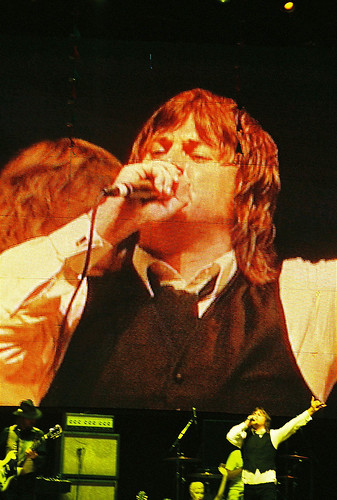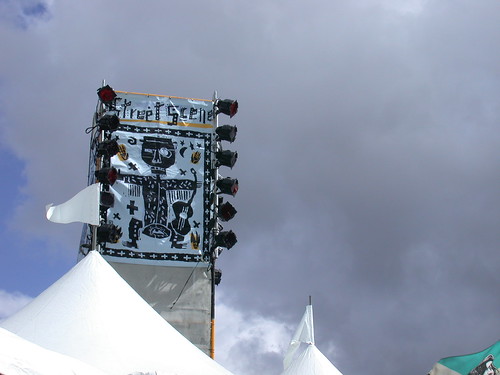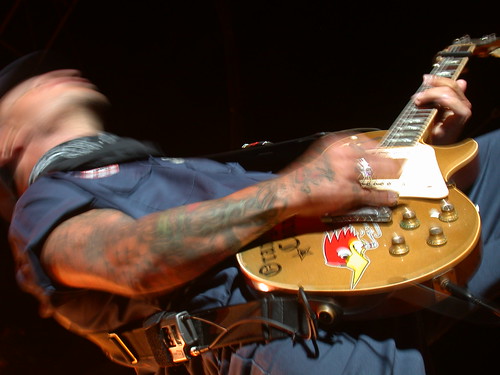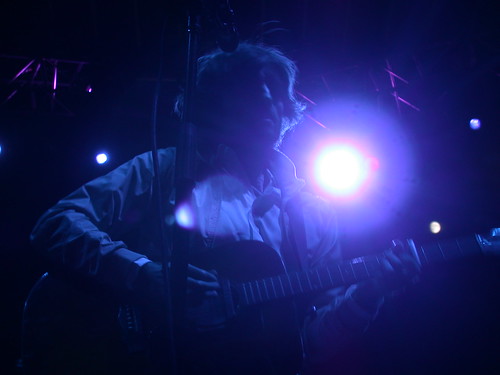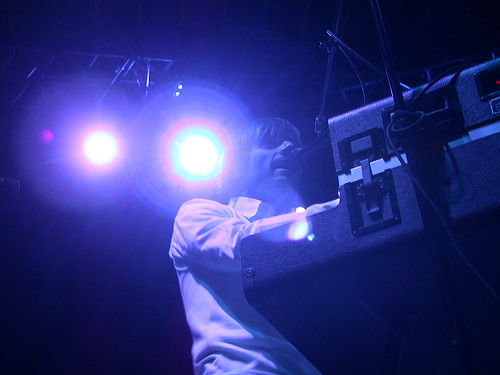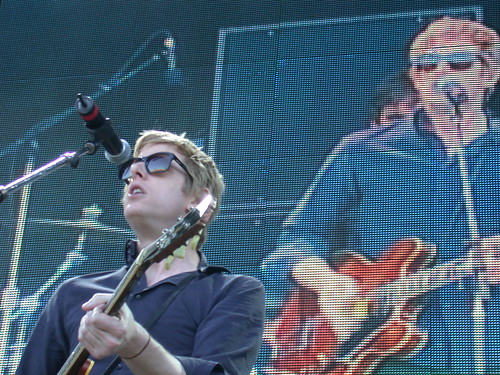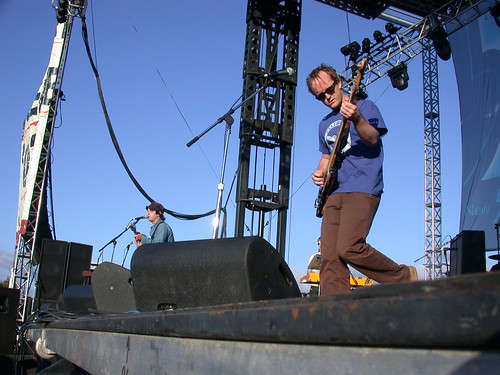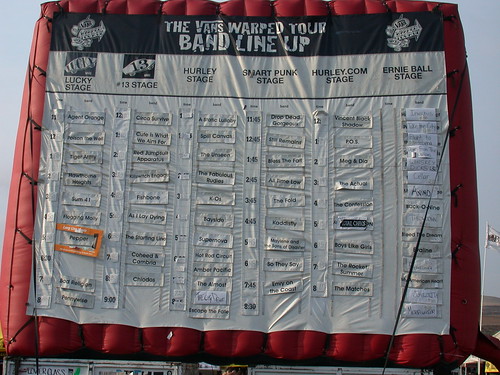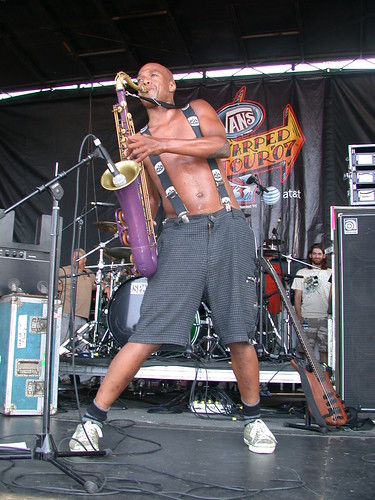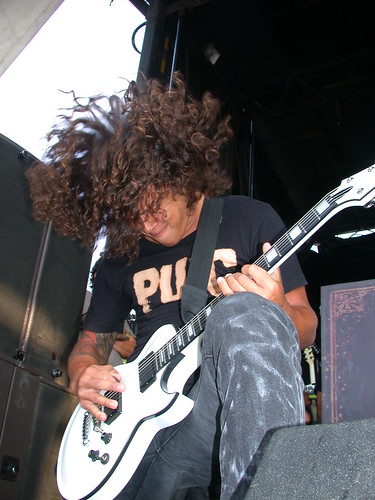It's not the same festival five years ago or even last year, but San Diego's signature music festival is coming to Coors Amphitheatre this weekend. The lineup isn't as strong this year, and the only street is the one that will be choked with traffic leading to the outdoor amphitheatre in Chula Vista, but Street Scene is here. I wrote previews for both the Union-Tribune and the OC Register, along with
a slew of profiles for SignOnSanDiego.com's Street Scene feature.
I'll be there this weekend taking photos and joting down notes.
Here's the Union-Tribune piece:
Stop me if you've heard this one ...
... the Brits are coming! English bands – the Invasion, Take II
By Chris Nixon
For the Union-Tribune
September 20, 2007 It was 20 years ago today, Sergeant Pepper taught the band to play ... actually it was more than four decades ago.
The Beatles stormed America in 1964, launching the first British Invasion on these shores, and Brit bands have occupied the minds of music aficionados on this side of the pond ever since.
Enter Street Scene, San Diego's signature music festival.
As festival founder Rob Hagey skewed the demographic younger every year since 2000, the Brit indie pop quotient has increased. In 2005, Kasabian and Hard-Fi represented. The following year, Bloc Party, Editors, The Futureheads and Nine Black Alps all made the journey to San Diego to ply their wares.
This year, Birmingham's Editors returns, along with Arctic Monkeys, Simian Mobile Disco, Paolo Nutini and Saturday's headliners Muse.
DETAILS
Street Scene 2007When: Saturday, noon to 11:30 p.m.; Sunday, noon to 11 p.m.
Where: Coors Amphitheatre, Chula Vista
Tickets: $65 per day
Phone: (619) 220-TIXS
Online: www.ticketmaster.com
Every year, dozens of new bands come out of England, Scotland or Ireland, renewing the U.K.'s status as a mainstay of indie rock.
“It seems pretty vibrant, pretty colorful,” said Editors lead singer and guitarist Tom Smith during a recent concert stop in New York City. “There's a lot going on. A lot of people talk about the second coming of the golden Brit pop years. But I don't really believe that.”
Smith is right: There can't be a second coming. In fact, pop music from the U.K. never stopped influencing American bands.
British groups don't have the stranglehold on the charts as they did in the 1960s, but a constant stream of young talent continues to pour out of the U.K. And the admiration is mutual on both sides of the Atlantic: “I may not be the best person to talk to, because most of the indie bands that I take to heart or I fall in love with are American,” said Smith.
“I like Klaxons. I think they're a really interesting band. But I love The National's record. I think they're an amazing band. LCD Soundsystem, Arcade Fire, these are the bands from recent times that I've really fallen in love with.”
Arctic Monkeys, sharing the Street Scene bill with Editors this year, rocketed into mainstream success with the 2006 disc “Whatever People Say I Am, That's What I'm Not,” the fastest selling debut album in British music history. Despite a general downtrend in record sales for most British bands, opportunities abound for young bands trying to get their start.
“Record sales aren't doing as much as they were 10 years ago,” said Smith, whose own band just released its second record “An End Has a Start.” “But there are more and more people going to shows. A new band on their first record will get to play Brixton Academy in the U.K. now. Years ago, you wouldn't get to Brixton until your second or third record. So, people are hungry for new music and hungry for live music. It's a good time to be in a band.”
It's a good time to be a music fan, too. With touring becoming the driving force behind a band's success, more groups are coming to the U.S. from the U.K. to tour.
“It's so hard to get on the radio here; it's nearly impossible,” said Smith. “So, you have to bring it to the people. We enjoy coming here and we always have a good time. We're aware that we're in the very early stages of the new record here,” he said.
“Of course, we'd like to be successful here. And I think given enough time we feel that American audiences will get it. I don't expect it to happen with this record. Hopefully, we can continue doing what we're doing and eventually take a bite of the big American apple.”
Despite Smith's comments, the Editors have made inroads into the American market. The band's first album, “The Back Room,” was packed with heady New Wave-layered guitars and catchy choruses, reaching No. 14 on the U.S. Heatseeker Chart. And, bolstered by the singles “Smokers Outside the Hospital Doors” and the title track, “An End Has a Start” climbed to No. 1 on the same chart.
More bands gaining early acceptance in their careers makes for a healthier music scene in the United Kingdom, Smith said, and that trickles across the Atlantic to the U.S.
“I can understand when the music fans get disillusioned when there's a new band every few weeks. But if you don't read the NME and you don't take that kind of music journalism to heart and you make decisions for yourself, I don't think it can be a bad thing.
“As in any era of music, if the band is good enough and they have good songs, the test of time will sort the wheat from the chaff. Won't it?”
Chris Nixon is a San Diego music writer.
And here's the OC Register piece (please note that Mike Ness is a morning person, and like to conduct interviews at the crack of 9 a.m. when he's not on tour....Mike Ness!):
San Diego's Street Scene is on the move again
Pushed out of the city's downtown in recent years, the festival takes place this weekend at a new venue in Chula Vista.
By CHRIS NIXON
For the RegisterFor the past 23 years, Street Scene has gathered together the diverse musical interests of Southern California on the streets and open spaces of San Diego. The festival was originally located on the streets of the then-seedy downtown Gaslamp District and founder Rob Hagey helped define the area as an entertainment destination, bringing in bands such as R.E.M., Ben Harper, Wilco, Wyclef Jean and Black Eyed Peas to name just a few.
By 2005, the Gaslamp and East Village neighborhoods had grown into upscale entertainment districts and residential areas, and the residents weren't happy about loud music blaring through their windows one weekend a year. Forced out of downtown, Hagey moved the festival to Qualcomm Stadium's parking lot. The move provided easy access to the trolley and obviously ample parking, but festival goers complained about enduring the scorching hot pavement and unofficially dubbed the show "Parking Lot Scene."
This year Hagey teamed with the Los Angeles based Live Nation to help promote the show. Street Scene was originally scheduled to take play at the Del Mar Fairgrounds. But the failure to book a big-time headliner and sluggish ticket sales forced the festival south to Coors Amphitheatre. Live Nation owns the 20,000-capacity venue. Street Scene this year will feature over 60 artists on five stages, with headliners Muse anchoring Saturday's lineup and the Killers holding down Sunday.
One thing has been constant through all the changes: Orange County's Social Distortion. Mike Ness and company have played the festival for the past five years, starting in the Gaslamp Quarter, through the years at the stadium and now in Chula Vista.
"It's kind of cool, because it feels like we've become a staple in Street Scene, wherever it's held," said a deadpan Ness.
Like many Street Scene fans who have been visiting the festival over the years, Ness misses the feel of Street Scene when it lived downtown: "I just remember doing it on Friday at 11 o'clock downtown. It was overwhelming. It literally felt like the whole city of San Diego was there standing in the middle of the street. It was like the town square almost. It felt really surreal. I don't know the word for it. It just felt really awesome."
Ness knows what he's talking about on the subject of music festivals; he's headlined many over the years. The 45-year-old singer grew up in Fullerton before forming Social Distortion in 1978. Alongside other young punks like the Youth Brigade and the Adolescents, the band quickly became nationally known in the underground punk scene.
Mixing traditional punk with country and rockabilly influences, Social D found a home on alternative radio stations in the '90s with songs like "Ball and Chain" "Story of My Life" and a cover of Johnny Cash's "Ring of Fire."
Social Distortion started playing Street Scene at the height of its popularity. The festival was drawing over 100,000 people in 2004.
"Unfortunately, things change and you have to adapt," said Ness. "I think it's a great event. And when it finds its final place, I think it will be a long-lasting thing. But it's so important where it's held. To me, if I lived in San Diego I would want to go to a cool place and see cool bands. Unfortunately, stadiums and parking lots are sterile.
"A rock vibe is hard to create. You throw a stage up anywhere and bring in a P.A. system and some lights and you have a show. Technically that's true. But it's always nicer if you have something with a vibe."
Hagey and Live Nation are hoping Coors provides Ness' definition of "vibe." Traditionally, Street Scene's lineup came from all over the musical map: reggae, world music, funk, rock, punk and soul. Since the record setting crowds of 2004, Hagey has booked acts that appeal to a younger demographic: AFI (2004, 2006), Ludacris (2004), the Used (2005), Yellowcard (2004, 2006), Method Man (2005, Kanye West (2006) and Matchbook Romance (2006).
This year's lineup includes a slew of young rock bands that appeal to even younger audiences: Panic! at the Disco, Augustana, The Academy Is…, The Rocket Summer, Brand New Tiger Army and Gym Class Heroes. You also have a select few mainstream hip-hop acts like T.I., Too and T-Pain. Throw in some reggae and world beat (B-Side Players, Eek-A-Mouse, Steel Pulse, Ozomatli, Pepper) and a few annual favorites (Social D, G. Love & Special Sauce, Slightly Stoopid) and you have the general thinking behind this year's Street Scene.
For Ness, Street Scene marks an annual string of shows running through Southern California and the Southwest. No matter the venue, Social D pencils in the music fest every September: "We look forward to it every year. It's nice playing outdoors and the weather is usually pretty nice. It's just a show that we always look forward to."



